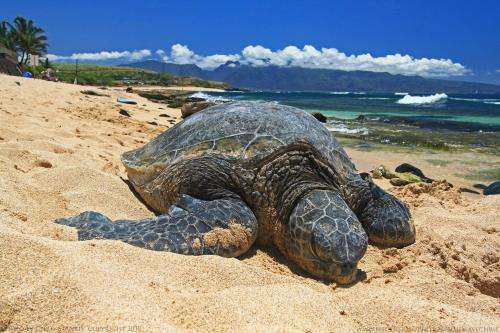Credit: ChrisStankis / Flickr, Bluewavechris
(Phys.org)—A trio of researchers, two from the U.S. and one from Greece, has found evidence that suggests green turtles may soon stop basking on Pacific beaches. In their paper published in The Royal Society Biology Letters, Kyle Van Houtan, John Halley and Wendy Marks describe a six year study of the sea turtles they conducted and why they believe the turtles will soon stop venturing onto beaches.
Green turtles are pretty big, growing up to five feet long, and inhabit most of the world's oceans—they have always been a familiar sight to visitors of beaches in Hawaii and other places around the Pacific—unlike other turtles that climb out of the water to briefly to lay eggs, green turtles come ashore and hang around, apparently basking in the sun. To find out why they do so, the researchers (two of whom are affiliated with NOAA Fisheries in Hawaii) set up a study where volunteers would count the number of turtles they spotted on a particular Hawaiian beach over a period of six years. The researchers combined the data from the volunteers with other data, such as from weather and ocean temperature sensors and found that the turtles tended to come out of the water when the sea temperature fell below 23°C. For Hawaii, and other Pacific beaches, that generally only happens during the winter months.
The researchers note that sea temperatures are rising—in that part of the Pacific it's about 0.04°C per year. That means that by 2039, ocean temperatures around Hawaii will likely rise above the exit point for the turtles and by 2100, the rest of the oceans will follow suit. That could mean, the researchers point out, that green turtles may quit coming onto beaches altogether, choosing to spend their entire lives in the water. They can't say, of course, what other impacts this might have on the species, as it's still not clear why the turtles need to warm themselves on beaches as compared to other turtles. The team plans to continue studying the turtles, hoping to solve that mystery, and looking to better understand if warming oceans will present a threat to the big familiar turtles.
More information: Terrestrial basking sea turtles are responding to spatio-temporal sea surface temperature patterns, Biology Letters, Published 14 January 2015. DOI: 10.1098/rsbl.2014.0744
Abstract
Naturalists as early as Darwin observed terrestrial basking in green turtles (Chelonia mydas), but the distribution and environmental influences of this behaviour are poorly understood. Here, we examined 6 years of daily basking surveys in Hawaii and compared them with the phenology of local sea surface temperatures (SST). Data and models indicated basking peaks when SST is coolest, and we found this timeline consistent with bone stress markings. Next, we assessed the decadal SST profiles for the 11 global green turtle populations. Basking generally occurs when winter SST falls below 23°C. From 1990 to 2014, the SST for these populations warmed an average 0.04°C yr−1 (range 0.01–0.09°C yr−1); roughly three times the observed global average over this period. Owing to projected future warming at basking sites, we estimated terrestrial basking in green turtles may cease globally by 2100. To predict and manage for future climate change, we encourage a more detailed understanding for how climate influences organismal biology.
Journal information: Biology Letters
© 2015 Phys.org





















